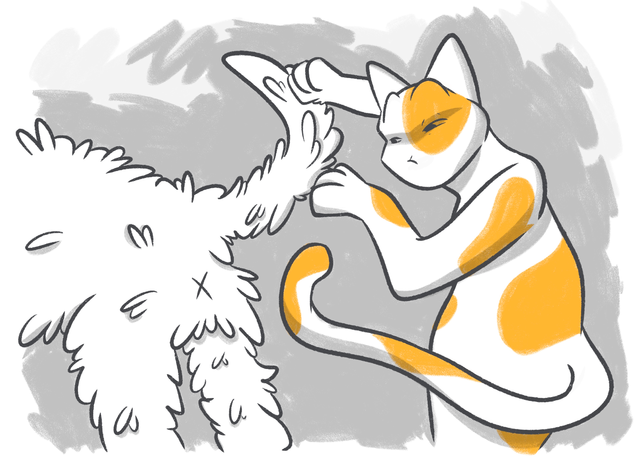Don’t you just love how dogs wag their tails whenever they’re excited to see you? If you’re a dog owner, you’ve probably noticed how your dog’s tail behaves. But have you ever wondered what a dog’s tail is? What is the purpose of a dog’s tail? Below are some answers to some common questions that you may have about your furry friend’s tail.
Stop Googling - Ask a Real Vet
Content:
- Why Do Dogs Have Tails
- What are Dog Tails Made Of
- Can a Dog Break Their Tail
- Why is My Dog Biting Their Tail
- Can Dogs Feel Their Tails
- Conclusion
Why Do Dogs Have Tails
You’ve probably wondered, "Why do dogs have tails? It’s a given that dogs’ tails are adorable, but did you know that the tail has important uses in a dog’s daily life? So what is a dog’s tail for?
- Movement
Observe how your dog’s tail behaves when they move. Whenever they want to change direction, they need help from the body. As your dog goes in a different direction, for example, the tail will also turn in that new direction. When in action, your dog’s tail helps in skillful movement.
- Balance
A dog’s tail also helps them maintain their balance. For example, when a dog tilts their head, the tail goes to the opposite side to balance the weight. Meanwhile, dogs that like to climb on different surfaces make use of their tails to help them balance on uneven surfaces like rocks.
- Communication
This doesn’t come as a surprise, especially for dog owners who are greeted with wagging tails by their canine companions. In the wild, dogs use their tails to communicate with other dogs, but we’ve somehow learned to recognize what they’re trying to say.
When the tail is wagging towards the right, for example, it may mean that a dog is happy and excited. On the other hand, if it wags towards the left, it may be a signal that they’re angry. Meanwhile, a tail that is tucked between the legs may mean that a dog is afraid.
What are Dog Tails Made Of
Anatomy of a Dog Tail
When you see a dog’s tail, you may have wondered: "What are dogs’ tails made of, and do dogs have bones in their tails? An extension of their backbone, it’s interesting to know that a dog’s tail is made up of bones, cartilage, muscles, and nerves.
In particular, a dog’s tail has between 6 and 23 caudal vertebrae, around 4 and 7 paired nerves, and muscles that envelope the vertebrae. All these parts aid in controlling a dog's tail movement.
Tendons enable a dog to move their tail in any direction. The cartilage, which is an elastic connective tissue in between the vertebrae, provides a cushion as the joints of the tail move. This allows for fluid movement.
Can a Dog Break Their Tail
Like other parts of their bodies with bones, dogs can also break their tails. The occurrence of a fractured tail is usually due to a dog getting hit by a car when their tail gets caught in a banged door or when they fall from a bed.
A broken dog tail may need attention. How serious the fracture is depends on which part of the tail is affected. If the fracture is at the tail's tip, it often heals well on its own, although a kink may sometimes be sustained.
On the other hand, if the dog's tail is crushed, affecting the bones, a section of the tail may need to be amputated. Injuries located close to the base of the tail usually sustain damage to the nerves and are more severe.
If your dog fell badly or got hit by a car, it is necessary to bring them to the vet immediately to be thoroughly examined.
Injuries such as a broken dog tail may need immediate veterinary care. With this comes unexpected veterinary care expenses. Because of possible pet emergencies such as this, it is best to be prepared by having a pet Emergency Fund. That way, you won’t have to worry about expensive vet bills while you take care of your dog.
Why is My Dog Biting Their Tail
There are various possible reasons why a dog keeps biting their tail. These include:
Fleas tend to gather around the base of the tail, so if a dog is biting at the base of their tail, fleas could be the culprit.

Hot spots are also a common reason why a dog chews their tail base. According to The American Kennel Club study, dogs such as bulldogs or pugs may be more prone to this since they have folds near the base of their tails that may trap moisture and result in hot spots. Hotspots are itchy, so it won’t be a surprise to see them biting and chewing at their tail base if they have them.
Having a good-quality pet camera such as the Petcube Cam will come in handy when monitoring your dog for signs of tail biting or any other symptoms of illness. That way, you may be able to address the underlying issue early on.
Can Dogs Feel Their Tails
Have you ever accidentally stepped on your dog’s tail? If you have, you’re probably aware that dogs can indeed feel their tails. Because the dog’s tail contains tendons and nerves, this enables them to feel pain when their tail gets injured or hurt in any way. This is why when you accidentally step on a dog’s tail, they react by showing signs of pain, such as crying out.
Conclusion
A dog’s tail is not only adorable, but it is also very useful for dogs when it comes to movement, balance, and communication. And because it is made up of bones, nerves, muscles, and cartilage, a dog can feel their tail and can also feel pain when it is injured. If your dog is showing symptoms of itchiness or pain in their tail, it’s best to consult with a veterinarian to determine what is causing it.
Was this article helpful?
Help us make our articles even better









